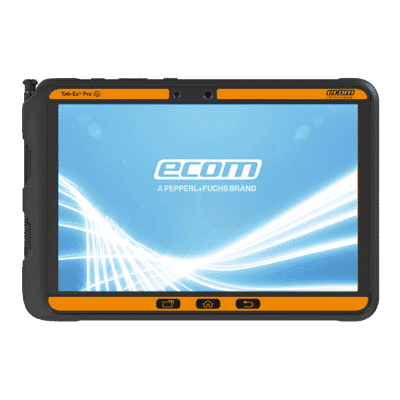Push to Talk: the cell phone with radio
Up to now, radios have been used for fast and secure communication on construction sites, industrial plants or extensive premises. Meanwhile, smartphones with push-to-talk function make extra devices superfluous. They bring together modern digital performance with traditional radio – and are thus superior to classic walkie talkies in many respects.

What is Push-to-Talk?
Push-to-talk, or PPT for short, is a voice radio technology based on mobile networks. It is not new, but has been used in mobile communications for many decades.
In some cases, the term push-over cellular, PoC, is used synonymously. It alludes to the fact that the mobile network (Cellular) is used to transmit voice messages.
The name describes what Push-to-Talk has to offer: You press a button and can record a voice message, which is then sent via a mobile device. There are two options for reception: Either the messages can be heard directly or they are only played when a user selects them via a button.
Messages can be sent not only to individuals, but to groups. Depending on the software used, various additional functions can be used, for example, voice messages can be saved and listened to again later.
At its core, the function corresponds to what WhatsApp and other messenger services also do. As a result, push-to-talk has not been able to establish itself in the consumer market, at least in Germany.
In the corporate context, however, PPT has become established and has even largely replaced analog radio in some industries.
How does Push-to-Talk work?
Push-to-talk technology uses the cellular network to transmit voice messages.
The transmission works similarly to the “Voice over IP” method. The speech is divided into data packets and sent to a server, which forwards them to the recipients. Depending on the speed of the network, whether UMTS or LTE, and the reception situation, the voice message arrives with a slight delay. The voice messages themselves are sent in the so-called Real Time Protocol.
Push-to-Talk establishes half-duplex connections, i.e. the server can only forward messages from one sender at a time. If other participants of the receiving group try to send in parallel, the messages will not be forwarded by the server.
Anyone who wants to use Push-to-Talk does not need any special hardware. Previously, the technology was not supported by every smartphone. Only certain brands and models were set to PPT on the operating system side. Today this is different: equipped with the right software, PPT is usable on most mobile devices.
Push-to-talk dissemination
In Germany, Telekom had tried to establish PPT in the B2C market in the noughties. However, customer response was so subdued that the company withdrew the technology from its product range in 2008.
In the B2B environment, on the other hand, the technology spread in Germany, driven by a few large providers such as TASSTA. One of the main arguments in favor of PPT: the transmission quality was and is clearly superior to traditional radio. In the U.S., push-to-talk has now become the standard in some industries, such as the cab industry.
Industries where push-to-talk is used:
- Agriculture
- Military
- Cab and transport services
- Rescue workers
- Construction projects
- Logistics
- Industry
- Event Industry
- Security company
Advantages of Push-to-Talk in enterprise use
Push-to-Talk is an alternative for companies that previously used digital radio or want to introduce a radio solution for fast and stable communication for the first time.
Do employees who are servicing a piece of equipment want to get a quick info from their colleague at the other end of the job site? Instead of having to carry a radio, Push-to-Talk lets them simply pull up an app on their smartphone or work tablet and get their message through with the tap of a finger. Latency is minimal, so the colleague knows immediately and can respond.
The best: Some of our industry smartphones and industrial tablets are equipped with large loudspeakers, so that communication is no problem even in environments with strong machine noise.
No WLAN connections need to be available and no company radio networks need to be set up for communication. The transmission can take place via the public mobile network. This makes push-to-talk much more cost-efficient than conventional or digital radio.
Why not just call or use messenger services? Push-to-Talk is optimized for fast delivery of voice messages, even to groups. There are areas of operation where you can’t risk a message getting stuck at the server because of a poor Internet connection: Emergency services, express service providers, cab companies must be able to rely on their radio. But efficient communication between technicians is also of great importance in industry, where a machine failure can have high economic consequences.
Learn more about maintenance and servicing here
The quality of PPT is similar to digital radio, but the voice is transmitted even more clearly.
In addition, users get more additional features – depending on which software they use. For example, companies can use the application to centrally set up groups for different teams or areas of operation and thus keep radio traffic clear. Users can save messages and listen to the history again depending on the configuration.
Advantages at a glance
- Short latency
- First class audio quality
- Voice message history
- Clear communication: only one person can speak at a time
- No extra infrastructure necessary
- Realizable with various mobile devices
Here you our extensive range of smartphones and tablets for the industry.
Introduction of Push-to-Talk in the company
If you want to use Push-to-Talk for communication with employees, you usually only need suitable software. In Germany belongs TASSTA to the established providers. The PPT solution is particularly comprehensive and DGUV-certified.
The applications can be installed on popular mobile devices with Android operating system.
For the industrial context, it is recommended to use robust industrial smartphones or tablets. Also devices ATEX certified offer the PTT function.
If you do not yet have any corresponding devices in use, we recommend the ecom Tab-Ex® DZ2 as a tablet and the i.safe MOBILE IS530.RG as a smartphone.
The tablet ecom Tab-Ex® DZ2 with high-resolution 8-inch display and Android operating system impresses with first-class computing power and a range of additional functions designed for industrial use (augmented reality, gyroscope, face recognition). This makes it easy to operate with gloves, in wet and high temperatures, and in potentially explosive environments. Sensitive corporate data is safe on the device thanks to Knox 3.2. The battery runtime of up to 11 hours is also impressive.
The rugged 4.5-inch smartphone i.safe MOBILE IS530.RG is optimized for working use. The device is equipped with a removable 3600mAh battery, IP68-certified Gorilla Glass and a multifunctional ISM interface, and can be operated with gloves. Operating system is Android 9.
Conclusion: Practical but underestimated technology
Push-to-talk is not very widespread in Germany, but wrongly so. In industrial use, the technology is an excellent and cost-effective alternative to traditional or digital radio over corporate networks. Especially for mission critical communication to multiple recipients, transmission via mobile network is the best solution.
Employees do not need extra radios, but can use existing devices such as smartphones or tablets, which in the best case bundle all the functions required for their work.
Want to learn more about the benefits of smartphones, tablets and data glasses in industry? Then call.

